|
|
 |
Fiche d'espèce de Copépode |
|
|
Calanoida ( Ordre ) |
|
|
|
Clausocalanoidea ( Superfamille ) |
|
|
|
Phaennidae ( Famille ) |
|
|
|
Onchocalanus ( Genre ) |
|
|
| |
Onchocalanus cristatus (Wolfenden, 1904) (F,M) | |
| | | | | | | Syn.: | Xanthocalanus cristatus Wolfenden, 1904 (p.119, Descr.F, figs.F); 1906 (p.32, Rem.F); Pearson, 1906 (p.20);
? Xanthocalanus similis Esterly, 1906 a (p.68, figs.F);
? Onchocalanus rostratus Sars, 1912 a (p.654) | | | | Ref.: | | | Farran, 1908 b (p.49); A. Scott, 1909 (p.82, figs.F); Wolfenden, 1911 (p.277); With, 1915 (p.228, figs.F,M); Lysholm & Nordgaard, 1921 (p.18); Sars, 1925 (p.147, figs.F); Rose, 1929 (p.26); 1933 a (p.137, figs.F); Jespersen, 1934 (p.84); 1940 (p.34); C.B. Wilson, 1942 a (p.199, fig.F); Lysholm & al., 1945 (p.25); Sewell, 1948 (p.348, 501, 508, 546, 549); Vervoort, 1950 a (p.9, figs.F, Rem.); Tanaka, 1960 a (p.117, figs.M); Fagetti, 1962 (p.23); Vervoort, 1965 (p.31, Rem.); Harding, 1966 (p.24, figs.M); Owre & Foyo, 1967 (p.57, figs.F,M); Vives, 1972 (p.213, 214, figs.F); Björnberg & al., 1981 (p.637, figs.F); Bradford & al., 1983 (p.61, 67, figs.F,M, Rem.); Park, 1983 a (p.335, figs.F,M, Rem.); Roe, 1984 (p.357); Tanaka & Omori, 1992 (p.263, figs.F,M); Razouls, 1994 (p.103, figs.F,M); Chihara & Murano, 1997 (p.854, Pl.140,141: F,M); Vives & Shmeleva, 2007 (p.689, figs.F,M, Rem.) |  issued from : J.M. Bradford, L. Haakonssen & J.B. Jillett in Mem. N.Z. Oceanogr. Inst., 1983, 90. [p.68, Fig.37]. Female: A, habitus (dorsal); B, forehead (lateral view); C, Mx2; D, P5. Nota: Vervoort (1950) describes the terminal joint of female P5 as having a spine on both the inner and outer margins, while the south-west Pacific specimen has the inner spine only. Male: E, habitus (lateral left side); F, Mx2; G, P5; H, terminal part of left P5 exopod.
|
 issued from : T. Park in Antarct. Res. Ser. Washington, 1983, 39 (5). [p.340, Fig.13]. Female: a, forehead (lateral); b, last thoracic segments and urosome (lateral left side); c, idem (dorsal); d, forehead (dorsal); e, genital segment (lateral left side); f, Mxp; g, distal part of Mxp; h, P1 (posterior); i, P5 (posterior).
|
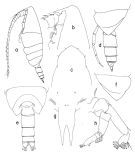 issued from : T. Park in Antarct. Res. Ser. Washington, 1983, 39 (5). [p.341, Fig.14]. Male: a, habitus (lateral left side); b, forehead (lateral); c, idem (dorsal); d, last thoracic segments with P5 and urosome (lateral left side); e, last thoracic segments and urosome (dorsal); f, posterior part of metasome (lateral right side); g, rostrum (anterior); h, A2.
|
 issued from : T. Park in Antarct. Res. Ser. Washington, 1983, 39 (5). [p.342, Fig.15]. Male: a, Md; b, Mx1; c, Mx2; d, Mxp; e, P1 (anterior); f, P2 (posterior); g, P5 (posterior); h, distal part of right P5; i, distal segment of left P5 (posterior).
|
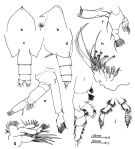 issued from : O. Tanaka & M. Omori in Publ. Sero Mar. Biol. Lab., 1992, 35 (4/5). [p.264, Fig.5]. Female (from Izu region, Japan): a, forehead (dorsal); b, idem (lateral); c, distal part metasome and urosome (dorsal); d, idem (lateral left side); e, A2; f, Md; g, Mx1; h, Mx2; i, P1; j, P5.
|
 issued from : O. Tanaka & M. Omori in Publ. Sero Mar. Biol. Lab., 1992, 35 (4/5). [p.265, Fig.6]. Male (from Izu region, Japan): a, rostrum (lateral); b, posterior part metasome and urosome (dorsal); c, A2; d, Mx1; e, Mxp; f, P5; g, h, distal part of left and right P5.
|
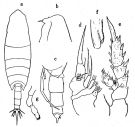 issued from : O. Tanaka in Publ. Sero Mar. Biol. Lab., 1960, VIII (1). [p.118, Fig.96]. Male (from Sagami Bay, Japan): a, habitus (dorsal); b, forehead (lateral); c, last thoracic segment with P5 and urosome (lateral left side); d, Mx2; e, P2; f, terminal spine of exopod of P2; g, right P5. Nota: In dorsal view the anterior margin of the head produced, forming a low crest. Lateral distal corner of the last thoracic segment triangularly produced and terminates into a sharp point. Abdomen 5-segmented, contained 3.1 times in the length of cephalothorax. The abdomen and caudal rami are in the proportional length 19 : 31 : 25 : 14: 5 : 5 = 100; the 2nd to 5th segments are furnished with small teeth on the distal margin. Caudal rami 1.6 times as wide as long. A1 extends to the distal end of the 3rd abdominal segment. The mouth parts as those of O. trigoniceps figured by Sars; Mx2 slightly reduced and soft-skined. The terminal spine of exopodite of P2 has about 60 serrations. Left P5 5-segmented and long, the distal segment terminates into a fine spine; right P5 3-jointed, the distal joint composed of 3 segments incompletely fused, and furnished on the distal margin with an outer marginal spine and short hairs.
|
 issued from: W. Vervoort in Zool. Verh. Leiden, 1950, 10. [p.10, Fig.1]. Female from Celebes Sea): a, cephalon (lateral right side), A1 removed; b, posterior part of cephalothorax and urosome (lateral right side).
|
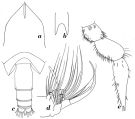 issued from: W. Vervoort in Zool. Verh. Leiden, 1950, 10. [p.11, Fig.2]. Female (from Celebes Sea): a, forehead (dorsal); b, rostrum (ventral view); c, posterior part of cephalothorax and urosome (dorsal); d, right Mx2; e, right P5 (posterior aspect). Nota: The abdominal segments and furca in the proportional lengths 41:27:17:4:11 = 100. Head and 1st thoracic segment separate, 4th and 5th separate (only visible on the dorsal surface). Head carinated. Urosome with very short, pickly hairs, in addition there are some ptches of longer hairs, closely packed together (especially on the rostral wall of the genital segment.
|
 Issued from : G.O. Sars in Résult. Camp. Scient. Prince Albert I, 69, pls.1-127 (1924). [Pl.XLI, figs.1-5]. Female: 1, habitus (dorsal); 2, idem (lateral left side); 3, forehead (lateral); 4, rostrum (frontal view); 5, P5.
|
 issued from : A. Scott in Siboga-Expedition, 1909, XIX a. [Plate XXXIV, Figs.1-8]. Female (from Halmahera Sea & Manipa Strait): 1, habitus (dorsal); 2, forehead (lateral); 3, last thoracic and genital segments (left side); 4, rostrum; 5, Mx2 (distal portion); 6, P2; 7, P4; 8, P5.
|
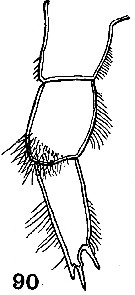 issued from : C.B. Wilson in Scientific Results of Cruise VII of the Carnegie during 1928-1929. Biology-I. Carnegie Inst. Wash. Publ. 536, 1942. [p.229, Fig.90]. Female (from SE Pacific): 90, P5.
|
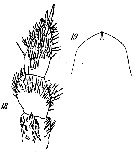 issued from : R.N. Wolfenden in J. mar. biol. Ass. U.K, 1904, VII (N.S.). [Pl.IX, Figs.18, 19]. Female (from off W Ireland): 18, P5; 19, forehead with prominet crest (dorsal). Nota: A1 extending to the end of the caudal rami. Mx2 with very strong curved hook on the 5th lobe; endopod with 7 short thick brush processes and a long thin curved vermiform process: Mxp with brush sensory process on the 1st basal segment.
|
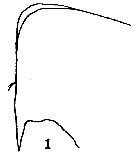 issued from : C.O. Esterly in Univ. Calif. Publs Zool., 1906, 3 (5). [Pl.9, Fig.1]. As Xanthocalanus similis. With doubt. Female (from San Diego, California): 1, forehead (lateral). Nota: A1 extend back as far as the posterior border of the cephalothorax.
|
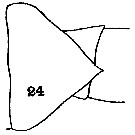 issued from : C.O. Esterly in Univ. Calif. Publs Zool., 1906, 3 (5). [Pl.10, Fig.24]. As Xanthocalanus similis. With doubt. Female: 24, last thoracic segment (lateral). Nota: Genital and anal segments equal in length, the 2nd segment the longest of the four. Rem: The first proximal segments are probably incorrectly figured.
|
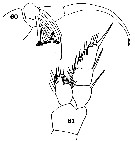 issued from : C.O. Esterly in Univ. Calif. Publs Zool., 1906, 3 (5). [Pl.12, Fig.60, 61]. As Xanthocalanus similis. With doubt. Female: 60, distal portion of Mx2 showing the sensory appendages; 61, P1. Nota: mx2 has 7 penicillate sensory appendages and 1 long, vermiform process, and a very long, heavy, curved hook on the terminal lobe. Mxp has a short penicillate sensory process on the outer margin of the 1st basal near the base of the segment.
|
 issued from : C.O. Esterly in Univ. Calif. Publs Zool., 1906, 3 (5). [Pl.13, Figs.71, 77]. As Xanthocalanus similis. With doubt. Female: 71, P3; 77, P5.
|
 issued from : C. With in The Danish Ingolf-Expedition, Copepoda I, 1915, III, 4. [Pl.VIII, Fig.17, a-b, f]. Female (from 61°30'N, 17°08'W): a, head (lateral; b, P2 (left endopodite); f, left P5.
|
 issued from : C. With in The Danish Ingolf-Expedition, Copepoda I, 1915, III, 4. [Pl. VII, Fig.6 a]. Female: a, left P5 (distal segment).
|
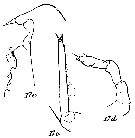 issued from : C. With in The Danish Ingolf-Expedition, Copepoda I, 1915, III, 4. [Pl. VIII, Fig.17, c-e]. Male: c, head (lateral); d, right P5 (anterior view); e, left P5 (distal exopodal segment).
|
 issued from : C. With in The Danish Ingolf-Expedition, Copepoda I, 1915, III, 4. [Pl. VII, Fig.6, b-c]. Male: b, corner of last thoracic segment and urosome (right lateral view); c, left Mx2.
|
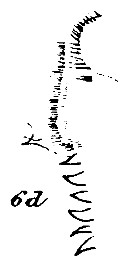 issued from : C. With in The Danish Ingolf-Expedition, Copepoda I, 1915, III, 4. [Pl. VII, Fig.6, d]. Male: serrula 6-dentata and lobus labialis (anterior view).
|
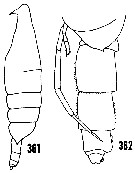 issued from : H.B. Owre & M. Foyo in Fauna Caribaea, 1, Crustacea, 1: Copepoda. Copepods of the Florida Current. [p.58, Figs.361, 362]. Female (from 14°55'N, 64°50'W): 361, habitus (lateral). Nota: Forehead with a crest. Male: 362, last thoracic segment with P5 and urosome (lateral).
|
 issued from : H.B. Owre & M. Foyo in Fauna Caribaea, 1, Crustacea, 1: Copepoda. Copepods of the Florida Current. [p.58, Figs.363-364]. Female: 363, rostrum; 364, P5.
|
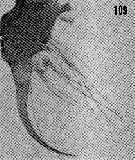 issued from : H.B. Owre & M. Foyo in Fauna Caribaea, 1, Crustacea, 1: Copepoda. Copepods of the Florida Current. [p.25, Fig.109]. Female: Mx2.
|
 issued from : H.B. Owre & M. Foyo in Fauna Caribaea, 1, Crustacea, 1: Copepoda. Copepods of the Florida Current. [p.25, Fig.111]. Female: 111, Mxp.
|
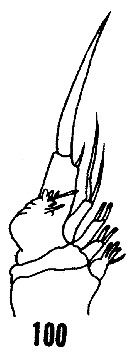 issued from : H.B. Owre & M. Foyo in Fauna Caribaea, 1, Crustacea, 1: Copepoda. Copepods of the Florida Current. [p.24, Fig.100]. Male: 100, Mx2.
|
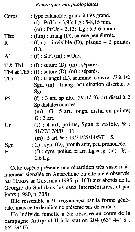 Issued from : C. Razouls in Ann. Inst. océanogr., Paris, 1994, 70 (1). [p.103]. Caractéristiques morphologiques de Onchocalanus cristatus femelle et mâle adultes. Terminologie et abbréviations: voir à Calanus propinquus.
| | | | | Ref. compl.: | | | Hardy & Gunther, 1935 (1936) (p.163, Rem.); C.B. Wilson, 1950 (p.273); Mazza, 1966 (p.70, as cristalus); Harding, 1966 (p.17, 71); Dunbar & Harding, 1968 (p.319, 321, 323: Rem.); Grice & Hulsemann, 1968 (tab.2); Roe, 1972 (p.277, tabl.1, tabl.2); Deevey & Brooks, 1977 (p.256, tab.2, Station "S"); Kovalev & Shmeleva, 1982 (p.83); Vives, 1982 (p.291); Lozano Soldevilla & al., 1988 (p.58); Razouls & al., 2000 (p.343, Appendix); Holmes, 2001 (p.56); Galbraith, 2009 (pers. comm.); Park & Ferrari, 2009 (p.143, Table 4, Appendix 1, biogeography); in CalCOFI regional list (MDO, Nov. 2013; M. Ohman, comm. pers.) | | | | NZ: | 17 | | |
|
Carte de distribution de Onchocalanus cristatus par zones géographiques
|
| | | | | | | | | | | | | Loc: | | | Antarct. (Atlant. SW), South Georgia, sub-Antarct. (Atlant. SW, Indian, Pacif. SE, SW), Brazil, G. of Guinea, off Morocco-Mauritania, Canary Is., off Madeira, Portugal, off W Cape Finisterre, Bay of Biscay, Azores, Caribbean Sea, Florida, off Bermuda: Station "S" (32°10'N, 64°30'W), Sargasso Sea, S Strait of Davis, ? Arct.: Fletcher's Ice Is. (in Dunbar & Harding, 1968), S Iceland, off W Ireland, W Medit. (Algiers Bay), Indonesia-Malaysia, Philippines, China Seas (South China Sea), Japan (Izu region), S Australia, Tasman Sea, New Zealand, British Columbia (rare), California, off NE Easter, off Juan Fernandez Is., S Chile | | | | N: | 36 | | | | Lg.: | | | (1) F: 7,3; (3) F: 6,35; (4) M: 6,2; (5) F: 6,6; (7) F: 8,15; 7,5; M: 6,5; (9) F: 6,65; M: 5,6; (15) F: 7,75-7,16; M: 6,5; (17) F: 6,5; (64) F: 6,9; (199) F: 7,36-5,32; (867) F: 6,3; M: 5,8; {F: 5,32-8,15; M: 5,60-6,50} | | | | Rem.: | méso-bathypélagique.
Sampling depth (Antarct., sub-Antarct.) : 0-2000 m.
Les tailles des femelles montrent de grandes différences: de 5 à 8,5 mm.
Pour Markhaseva & Kosobokova (1998, p.51) la forme citée par Harding (1966) et Dunbar & Harding (1968) serait une espèce différente: Onchocalanus cristogerens.
W. Zhang confirme la présence de cette espèce dans les mers de Chine (comm. pers., 2006).
Voir aussi les remarques en anglais | | | Dernière mise à jour : 28/01/2017 | |
|
|
 Toute utilisation de ce site pour une publication sera mentionnée avec la référence suivante : Toute utilisation de ce site pour une publication sera mentionnée avec la référence suivante :
Razouls C., Desreumaux N., Kouwenberg J. et de Bovée F., 2005-2025. - Biodiversité des Copépodes planctoniques marins (morphologie, répartition géographique et données biologiques). Sorbonne Université, CNRS. Disponible sur http://copepodes.obs-banyuls.fr [Accédé le 30 décembre 2025] © copyright 2005-2025 Sorbonne Université, CNRS
|
|
 |
 |































